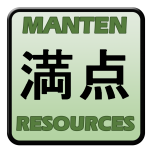Key Features of Jblog 2 Textbook
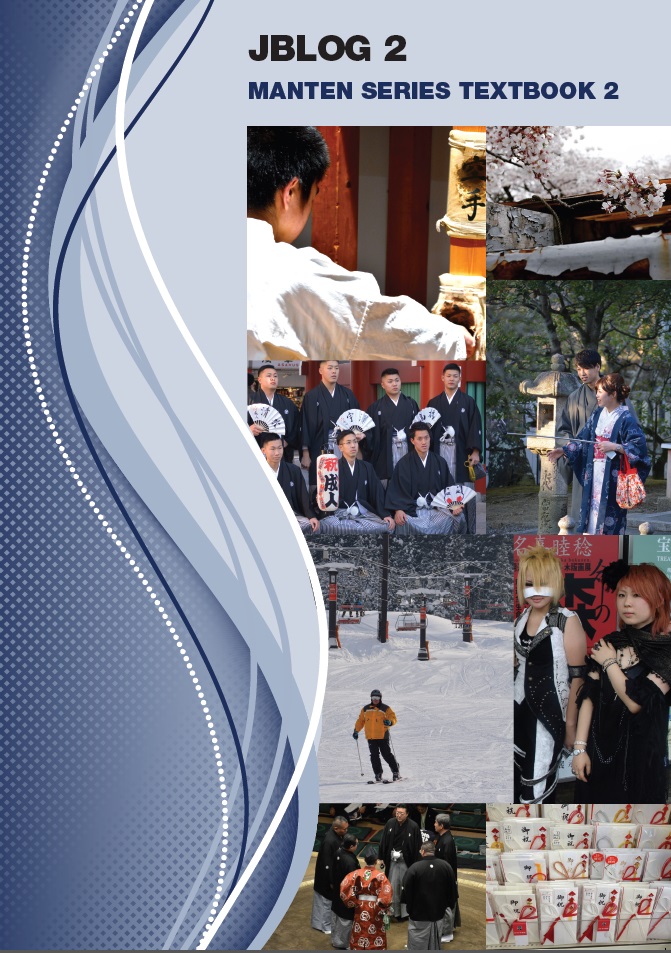
1. The chapter title page includes a chapter summary and an eye-catching photograph; students are more adept at learning from images than they are given credit for.
2. Jblog is a weblog that introduces the cultural background of the chapter. It has a side panel with focus Japanese words. Facts are detailed enough to keep even the most gifted students engaged.
3. The ski challenge section encourages students to try challenges according to their ability, with three levels of difficulty based on the ski run rating system of green for beginner, blue for intermediate, and black for advanced. Each chapter features one differentiated challenge. Worksheets and listening drills also follow this rating system.
4. The Ask Your Senpai column is based on an Agony Aunt column. A problem is posed to explain new concepts of the language, culture, or the language learning experience. For example, the problems you may encounter when using a dictionary.
5. Each chapter ends with Lucy’s Diary. Lucy is the more advanced younger sister in the textbook who models the language in more contextualised texts.
6. NEW: A Japanese Recipe. In Jblog 2, Jake begins Japanese cooking lessons with his mum. The recipes are in Japanese introducing the plain form in a non-threatening way. Students are too distracted by the food to notice! We recommend cooking these in class if possible.
7. NEW: 10-Second Genius. This is a short grab that allows students to improve their “genius” ability in 10 seconds, for example, using suffixes to create new words.
Topics covered in Jblog Textbook 2
Chapter 1: Hobbies and Interests
The first chapter of this textbook acknowledges the start of the elective course. Students may have been in various classes in Stage 4, and will bring with them varying levels of confidence in script, grammar and vocabulary. Chapter 1 revises the key concepts covered in the first textbook. It then develops the student’s ability to talk about their contemporary hobbies and interests, such as screen-based activities. A new text type is introduced in the form of a recipe and provides an opportunity to cook yakitori at school or at home. Such hands-on tasks are an excellent way to help maintain elective numbers in the first vital month of a course.
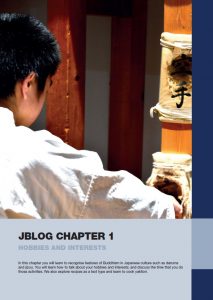
Content includes:
- A review of Jblog textbook 1 content
- Introduction to Buddhism
- Katakana – for café items & hobbies
- Links such as しかし、でも、も
- Modern free time activities & hobbies
- Festivals review & ひなまつり
- Numeracy re modern marriages
- Discussing the timing of activities
- Recipe : やきとり
- New Year games
- Texting in Japanese including emoticons
Chapter 2: My Family and Friends
This chapter introduces aspects of Japanese philosophy such as きんつぎandわびさび. Many students struggle with mental health and self-confidence issues, so these concepts are an excellent way to begin a discussion. The chapter also explores intercultural competency and develops an understanding of how their knowledge of language and culture works together to enable more positive interactions with others.
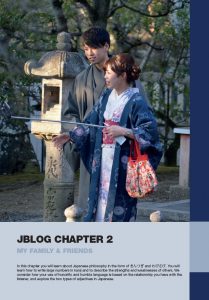
Content includes:
- Intercultural competency
- Humble vs honorific language
- Polite family members vocabulary
- School & year level
- Easy adjectives
- Strengths & weaknesses
- Large numbers
- Linking adjectives
- Haiku poetry
- Negating compliments
Chapter 3: Body Talk
The third chapter focuses on the body. Students progress from using basic skills to describe appearance to a reflection on how culture influences our clothing choices and sense of modesty. Interesting superstitions regarding teeth and umbilical cords are described, and rites of passage in Japanese culture such as 七五三andせいじんの日are explored.

Content includes:
- Body vocabulary
- たいいくの日 & うんどうかい
- 七五三 & せいじんの日
- Traditional clothing
- Recipe : おやこどん
- Discussing clothing & appearance
- Making suggestions – ましょう
- Counters : つ、本
- Literacy : editing a text
Chapter 4: Home Life
This chapter introduces features of Japanese home life such as futon, kotatsu, and bathing customs. Students develop the skills to describe the location of people and objects in a home and to describe what others are doing in specific rooms using present continuous verbs. The topic is concluded by considering the issue of homelessness in Australia and Japan. This is a good launch pad for schools considering supporting a cause through voluntary work or fundraising activities.
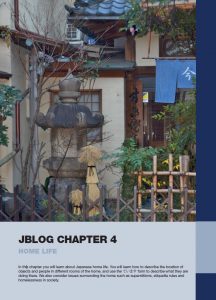
Content includes:
- Home life
- Features of a home
- います vs あります
- ています
- Discussing ability できます
- Numeracy task re Homelessness
- Shoe & slipper customs
- わしき vs ようしき
Chapter 5: Seasons
The fifth chapter offers a more contemporary exploration of the topic of seasons. Students progress from developing an understanding of seasonal associations in Japan to describing weather and snowfall rates at popular Japanese ski resorts. An investigation follows of natural phenomena such as earthquakes and tsunami in Japan, the effect on people (for example, following the events of Tohoku in 2011), and how people manage daily life under such conditions. We promote opportunities to support the Tohoku region through fundraising events or through tourism to Tohoku festivals such as Kanto and Nebuta.
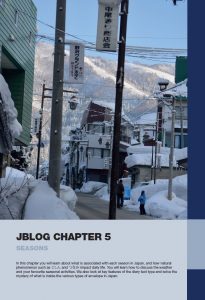
Content includes:
- Seasons
- Weather vocabulary
- どういたしまして vs とんでもない
- Types of weather reports (snow, local & world)
- Earthquakes & tsunami (including 2011)
- Festival focus : ねぶた & かんとう
- Recipe : やきそば
- Envelopes : wedding, funeral & おとしだま
- Using basic verbs across the 4 tenses
- Using basic adjectives across the 4 tenses
- Diary text type basics
Chapter 6: My Time
This chapter explores how people spend their time each day, and how happy they are spending it that way. It considers the issues surrounding childcare, over-worked fathers, and care for an ageing population. The role of robots in Japanese society is raised as a possible solution, and the concept “what is average?” is discussed. Traditional and contemporary lifestyles are explored, and students move beyond stereotypical beliefs to a deeper understanding of Japanese society.

Content includes:
- How people spend time – Japanese mums, dads, grandparents & students
- Robots and the elderly
- Kanji Prefixes for time : 先今来毎
- Numeracy task re graphs of activity frequency
- Daily routine vocabulary
- Comparison of “average” in Japan & Australia
- Focus on questions to elicit certain responses
- Kanji for verbs related to school life
- Adverbs – よく、あんまり、めったに、ぜんぜん
- Text type – interview re daily life of a teenager vs a grandmother
Chapter 7: Around Town
The seventh chapter introduces typical features of a Japanese neighbourhood, such asじんじゃ and こうばん. Students develop skills in making and negotiating plans with others, and learn the appropriate use of phrases to purchase food at different establishments. The chapter looks at apps that students can use to plan travel routes considering time and budget restrictions, and reveals “insider” tips on remembering kanji stroke order. The ultimate kanji challenge is also offered for the more determined students in the class.

Content includes:
- Around Town – shops & icons
- Features of a Japanese neighbourhood eg こうばん、じんじゃ、せんとう
- Suffixes for shops や & buildings かん
- Particle focus で、に、へ、と
- Recipe : ぎゅうどん
- Length of a journey
- Using www.hyperdia to budget & plan trips in Japan
- Declining suggestions ましょう、ちょっと
- Vocab & phrases for dining out & purchasing food – convenience stores vs McDonald’s vs café
- Tips to mastering kanji stroke order
- Text type focus – using surveys to collect and analyse data
Chapter 8: Content and Language Integrated Learning (CLIL) Unit – Sumo
The last chapter is an optional chapter that provides an introduction to CLIL pedagogical approaches. It is designed to be taught in an immersion-style environment but can be modified for a regular lesson setting. The topic of sumo wrestling provides the opportunity to consider the rise of non-Japanese wrestlers, the health concerns associated with the sport, the daily routines of a wrestler, and superstitions regarding beef and pork consumption. There are many cross-curricular content links available with this topic.
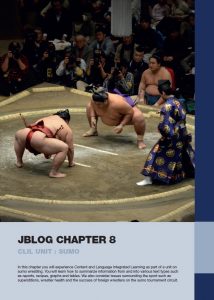
Content includes:
- This unit may be taught as a normal unit or as a CLIL unit
- Sumo wrestling
- Phrases for classroom interactions
- Cultural terms related to sumo eg mawashi
- Discussing height & weight
- Text type – report re health comparison of Australian & Japanese males & sumo wrestlers
- Vocabulary for discussing injury or illness
- Interpreting statistics re health & the impact on life expectancy
- Visiting a doctor role play
- Sumo wrestler daily routines
- Recipe : ちゃんこなべ
- Superstitions related to sumo
- Rules and rankings
